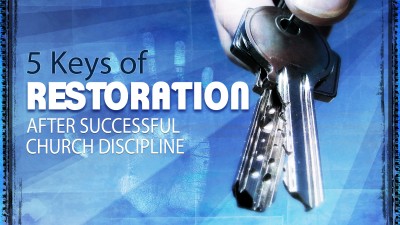Deep and Genuine Repentance Must Take Place. If this does not occur, restoration is elusive. Repentance is a change of mind that leads to a change in action—brokenness, genuine sorrow over sin, a desire for accountability (transparency), and humility are marks of sincere repentance. Time allows us to see if repentance is genuine or temporary.
Health and Healing Take Time. Time allows the church to gauge the depth of the repentance. Again, was it superficial and temporary, or was it real and sustainable? This time may, or may not include, reunion with the church. The goal is not a speedy recovery, but a healthy one. The person is encouraged to meet with counselors and accountability partners, and spend extended times reading, studying, and praying so that transformation takes place. Proverbs 18:1 says, “A man who isolates himself [quarantines or cuts off himself] seeks his own desire; he rages against all wise judgment.” Accountability hurts, but it is absolutely necessary. Time also allows the church to gauge progress – is the person remorseful or bitter?
Rebuilding Trust. Forgiveness is a decision, but trust is a process. During this time, the person fellowships and reunites with the congregation. If necessary, hard questions are asked and answered so that healing and clarification can take place. How the person handles this season is crucial in gauging their heart and their sincerity. There is often no set time frames on this process. Not rushing this process can be a real eye opener: are they still broken, humble, and appreciative, or are they getting hard, arrogant, and demanding? Time is God’s thermometer; it reveals the temperature, or the true condition of the heart.
Leadership Evaluates. All sin is sin, but the consequences often differ. For example, a gossiping leader who repents will be handled much differently than the person who commits adultery. During the initial stage, there is a concerted effort toward prayer and seeking God’s will. Leadership considers the perception of the congregation as well as the heart of God. Balance must be sought…restoration cannot occur at the cost of wounding others.
The overall needs of the congregation and the victim must outweigh, or at least balance with, the desire for restoration. It’s detrimental to the spiritual health of the church if reinstatement occurs too soon. “Shouldn’t we be eager to restore our fallen brethren? To fellowship, yes. But not to leadership. It is not an act of love to return a disqualified man to public ministry; it is an act of disobedience” (John MacArthur).
Healing comes with time. The waiting process welcomes feedback and examination; honest and open dialogue takes place…all concerns and comments are taken into consideration. However, special care must be taken to deal appropriately with those fostering a critical spirit toward the person being restored, especially if they are bitter, negative, and resentful. The focus is building up the offender and ministering to the victim, not in tearing down the offender and avoiding the victim. Leadership can use this opportunity to address and correct divisive attitudes before they spread. But we must not confuse concern with divisiveness.
Reinstatement is Discussed. If the person is to serve (obviously leadership roles would take longer and involve more), they must once again meet the criteria from 1 Timothy. Specifically, verse 10: “They must first be tested; and then if there is nothing against them, let them serve as deacons.” Elders (or those in leadership positions) will be held to an even higher standard. In both cases, if the discipline or informative meeting was public, I believe that the reinstatement should be public as well, or at least be considered. However, this step is not an open reinstatement; it’s an open “discussion” of the plans and progress thus far. This stage addresses current concerns, and potential fires can be extinguished. As with all stages, it’s wise to err on the side of moving too slowly than too quickly. There should be peace about the decision…we should not feel rushed or pressured when moving to the next stage.
Reinstatement Occurs. Again, if the discipline or informative meeting was public, reinstatement should be public as well (there are exceptions). Reinstatement does not mean full and unguarded service. Even at this stage, trust is still being established. The person must maintain a consistent walk, accountability, and godly character and take small steps toward serving again in full capacity.
During the entire process, the victim should be built up and encouraged as much (if not more so) than the “offender”, as in the case of adultery. We must minister to the families involved on both sides. All to often, we are quick to reinstate the fallen at the expense of the wounded. In my opinion, depending on the offense, some may never be reinstated to leadership positions.
The goal is not to fatally wound the person seeking restoration (although they may “feel” that way)—the ultimate goal is to restore both parties to spiritual health—the victim and the offender. In the same way that physical injury takes time to recover, spiritual injury (restoration) takes time as well. If a muscle is strained beyond the capacity of healing, more damage could result. If restoration is rushed before healing occurs, more damage can result.
These points are not absolutes. They are flexible biblical approaches to the challenges and dynamics associated with healing and restoration. Some situations may require more steps, and some individuals may never return to service, others however, may move more rapidly through the process. The ultimate goal is honoring God, showing grace, and protecting the congregation from unnecessary pain.
Shane Idleman is the founder and lead pastor of Westside Christian Fellowship in Lancaster, California, just North of Los Angeles. He recently released his 7th book, Desperate for More of God at shaneidleman.com. Shane’s sermons, articles, books, and radio program can all be found at wcfav.org. Follow him on Facebook at: facebook.com/confusedchurch.


